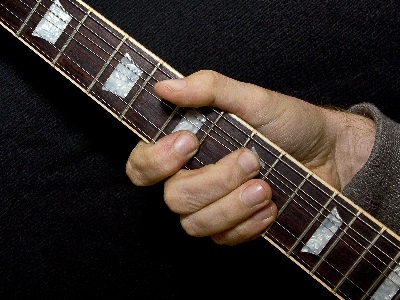Half Step Bends With Vibrato
Whether you play the blues or heavy metal, your vibrato technique is one of the key principles of your playing. While some blues players tend to over-bend the guitar strings and get horrid note leaps, some heavy metal guitarists tend to just wiggle the string and perform little more than a jiggle in the note.

So how do you find the in-between? How do you get the perfect bend that isn’t quite a note jumper or a wiggle? In this article we will discuss the common ground between the two; the half step vibrato bend.
Bending Is All About Feel.
Many guitarists in heavier music tend to have trouble with bends as they train themselves to play as fast as possible. This results in the bend being a rushed technique. If you play heavy music, let this article guide you on how to make the most of each bend.
Vibrato should be performed with two fingers. In most cases, the two fingers being used should be the ring finger and the index finger. They should be on the same string two frets apart. The note that you want to sound should be fretted by the ring finger. The index finger should be two frets away from it. The index finger’s fret will not sound. Don’t make the mistake of fretting the desired note with your index finger.
Mind The Amount of Space On The Fretboard
When you bend, there is a simple rule to the direction in which you push or pull the string. On the low E string, the A string, the D string, and the G string, you will be pulling the string downwards. On the B string and the high E string you will be pushing the strings upwards. This is all due to the amount of space available on the fret board. It will help you to get the most out of each bend without sacrificing your range.
On the lower frets, you can use a single finger for vibrato. Take for instance a bend on the second fret of the low E string. You can simply fret it with your index finger and bend the half step from there.
Tips to Getting Your Vibrato Bend Right
A great way to check your bend is to play the next fret. Each fret is a half step from the last. This means that if you do a proper bend, your note will be equal to the next fret. If you perform a half-step bend on the second fret of the low E string, the note F#, you should be able to release the bend and play the third fret, the note G, and have the notes match.
The best way to improve your vibrato is to practice. Remember, your bends are as much a part of your style as your riffing, legato, and sweeping. You should spend equal time developing your vibrato as you do develop your guitar soloing techniques.
It will make you a more dynamic player and will allow you to translate emotion more efficiently. Take your time and don’t rush; it takes time to develop good vibrato. Have fun, and good luck!
Jamplay – Awesome Teachers, Excellent Video instruction And Community

Jamplay is the LEADING online guitar lesson website that offers step-by-step videos in high-definition. They cover EVERY genre of guitar style and have comprehensive content for guitar players of any skill level.
Jamplay also showcases a continuously growing archive of instructional videos that’s updated weekly. What’s even better, they also offer indepth tutorials for members to learn popular songs with the help of precise, dynamic tabs and song demonstrations.
p.s: We’ve arranged a special deal for our readers. Get your exclusive Jamplay promotion code here…






Leave A Comment